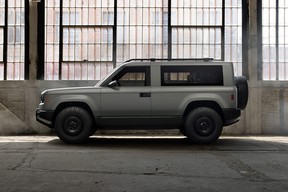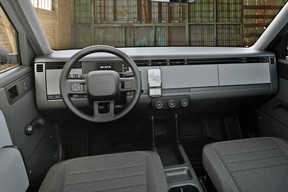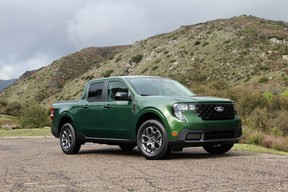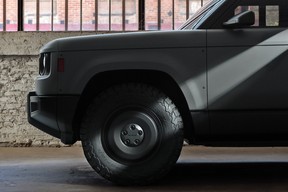Motor Mouth: Is Slate’s USD$20,000 EV real or not?
Is the American startup's low-cost electric pickup the cure to all that ails EVs, or just the industry’s latest parody of a real truck?

Article content
You’ve got to admit it got your attention. Love electric vehicles or hate ’em, always wanted a pickup truck or wouldn’t be caught dead in one, it made you look. Indeed, regardless of brand loyalty — and no one is more fervent in this regard than a truck owner — political affiliation or even if you have no intention to buy a car, Slate got your attention in April when it announced it was going to produce a US$20,000 battery-powered pickup. In an era in which automobile prices have skyrocketed and electric trucks — we’re looking at you, Elon — lead the charge to unaffordability, it seemed like a miracle. A miracle that made you think “if it’s too good to be true…”
And, as it turns out, it was.
That sub-twenty-thousand-dollars price tag was calculated after America’s US$7,500 federal EV tax credit had been applied. Now that Trump has killed that incentive, the Slate’s baseline MSRP will be closer to US$27,500. Not nearly as miraculous as 20 grand, but still a far cry from the US$45,000 sticker on the average car in America, the more than 50 large that most electrics demand, and a third of the price of most other battery-powered trucks. The big question on everyone’s lips was “Could they build it?” almost inevitably followed by “How?”
The quick answer to that first question, even for an avowed EV skeptic, is a cautious “yes.” Producing it in America, of course, makes miserly manufacturing problematic. On the other hand, it will also mean no tariffs, since Slate says even the battery will be built in the United States. Better yet, while Trump did cancel the EV consumer incentives that fuelled growth, the White House has kept the Biden-era’s Inflation Reduction Act proviso that pays automakers up to US$45/kilowatt-hour to produce their batteries in the United States. I’m guessing that, too, is factored into its low, low starting price.
Besides, the Slate pickup — it doesn’t have an official model name yet — truly is the Tata Nano of trucks. The bodywork is plastic; there is no paint, not even as an option (vinyl wraps are available, however). Rear seats are not included. Neither is a radio. There’s no interior trim to speak of. Other than a steering wheel, pedals, and, luckily, considering our recent heat waves, air conditioning, none of the usual amenities are standard equipment. Hell, the windows are manually-operated — something only we Boomers might remember. The miracle of “how,” then, is simply minimalism extremus. The average vehicle is made from more than 2,000 parts; Slate says its truck barely needs 500.
So, if we assume the company can build a US$27,500 battery-powered truck, the question then becomes “Will customers buy one?”

That’s more difficult to answer. Recent market trends would say not. Though consumer advocates make their bones on decrying corporate greed, the fact remains the cheap, cheerful cars we like to wax nostalgic about didn’t disappear because automakers stopped building them, but rather because consumers stopped buying them. Whether we’re all making more money — which, statistically, seems improbable — or we’re just financing our cars for longer, American and Canadian consumers alike are buying more featured-filled, and dare we say luxurious, cars than ever before.
According to Edmunds, Americans spend an average of 33% more than the base price of their cars in added options and pricier trim packages, up from 28% a decade ago. And that’s for cars that are already better equipped than the Slate will be.

Slate hasn’t revealed the cost of all its add-on accessories — everything from retrofitted electric windows to a rear cab that turns the pickup into an SUV — but even using Edmunds’ numbers, that points to a $36,000-plus on-the-road MSRP. Factor in that potential Slate owners will also have to pony up even for such rudimentaries as the aforementioned power windows and a rear seat before making their little pickup (semi-)luxurious, and chances are we’re looking at a US$40,000 truck.
That is, I suspect no one need reminding, roughly double what the company was promising just four months ago. Factor in that the “blank Slate,” as delivered in its base state, sports but a 52.7-kilowatt-hour battery (with just 240 kilometres of EPA-promised range) and that the optional 84.3-kWh “long range” version will assuredly add a further five grand to the base price, and we would seem a long, long way from cheap and cheerful.

This poses three distinct questions. First, will all those claiming to be excited about the prospect of a cheap, if extremely rudimentary, EV actually buy one when the final bill comes due? Deposits, even 100,000 of them as Slate claims it already has, are not a guarantee of actual sales — just ask Tesla. Second, might prospective Slate owners follow the same pattern as other North Americans, i.e. just load the little truck up with options like every other new vehicle they buy? Or, thirdly, might they simply look at its base price — those 27,500 greenbacks and/or their Canadian equivalent — and shop a more practical, albeit less electric, alternative?
History says the first option is unlikely. The North American marketplace is littered with the corpses of “great ideas” that promised cheap, back-to-basic mobility that never got off the ground. Hell, back in the naughts, there was even talk of bringing the aforementioned Tata to our shores, but saner heads prevailed.
If we assume the company can build a US$27,500 battery-powered truck, the question then becomes 'Will customers buy one?'
That said, all those failed micros were cars, and the Slate, despite its aforementioned minimalism, is a pickup. Even if its pickup attributes are significantly diminished — it can only tow 1,000 pounds — it is at least semi-practical. Might that permit this one micro-electric to go where previous minis have failed? Unknowable, but certainly Slate — and its shareholders, who reportedly include Jeff Bezos — hopes so.
As for the second, might people just reflect that, while not nearly as cheap as promised, circa-USD$40,000 is still cheaper than other electrified trucks? Ford and General Motors’ pickups are having a hard time gaining the foothold analysts all thought they’d find as soon as automakers married lithium-ion to truck bed. This, too, then, is uncertain, and largely depends on consumers specifically wanting an electric pickup, and not just any cheap semi-work vehicle.

Because option three is just buying a Maverick. For roughly the same money — USD$28,145 — you can get a Maverick XL from Ford, the hybrid version no less. It’s bigger, roomier, has four doors (and rear seats!) and appreciably more towing capacity.
And, while it isn’t electric, Ford’s hybrid system has proven quite effective, the EPA rating it at 40 (US) miles per gallon overall; my 2022 tester averaged a creditable 7.0 L/100 km. No, it’s not as green as the all-electric Slate, but I do suspect the environmental payback — when an EV’s reduced tailpipe emissions overcome its increased CO2 production during manufacture — will be longer than most battery-electrics. Simply put, for many, if not most, prospective customers, the same money buys more truck if you shopped Ford.

I suspect it is this last that will most seriously blunt Slate’s ambitions. After the early intenders and true believers peter out, any pickup will live and die on its practicality. Will gardeners and landscapers, long a captive audience for smaller pickups, live with its space limitations? Will powersports enthusiasts — bikers and ATVers both — sign up despite the limited towing ability? Especially when the Maverick Hybrid — or its even cheaper AWD gas version — can seat more, carry more, and haul more for similar money.
Slate says it wants to sell 150,000 of its electrified pickups annually, an ambitious target for a startup in any economy, even tougher now that the bloom is off the EV rose. Tesla sales are down, Lucid and Rivian reported huge losses just this week, and, even in China — the home of cheap EVs — most automakers remain unprofitable.
In the end, Slate’s future will depend on three crucial elements: that it is electric, cheap, and a truck. And that thanks to Trump, being built in America could prove a significant advantage, once the full effect of his tariffs hit U.S. consumers.
Is that enough? I’m not sure. But it ain’t going to sell in Texas. Alberta either. And, no matter how we proselytize about the environment, if Bezos is to get his money back, Slate will need at least some traditional truck intenders.
Sign up for our newsletter Blind-Spot Monitor and follow our social channels on X, Tiktok and LinkedIn to stay up to date on the latest automotive news, reviews, car culture, and vehicle shopping advice.













Postmedia is committed to maintaining a lively but civil forum for discussion. Please keep comments relevant and respectful. Comments may take up to an hour to appear on the site. You will receive an email if there is a reply to your comment, an update to a thread you follow or if a user you follow comments. Visit our Community Guidelines for more information.